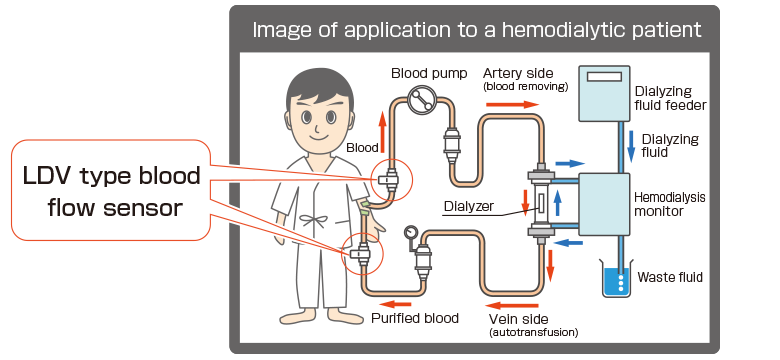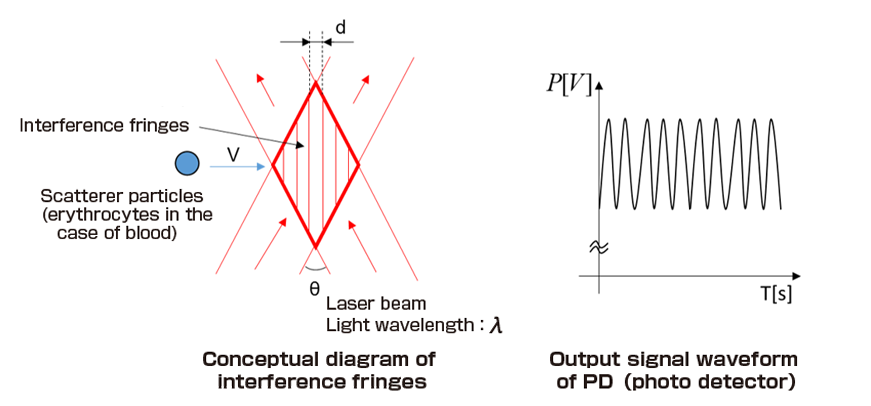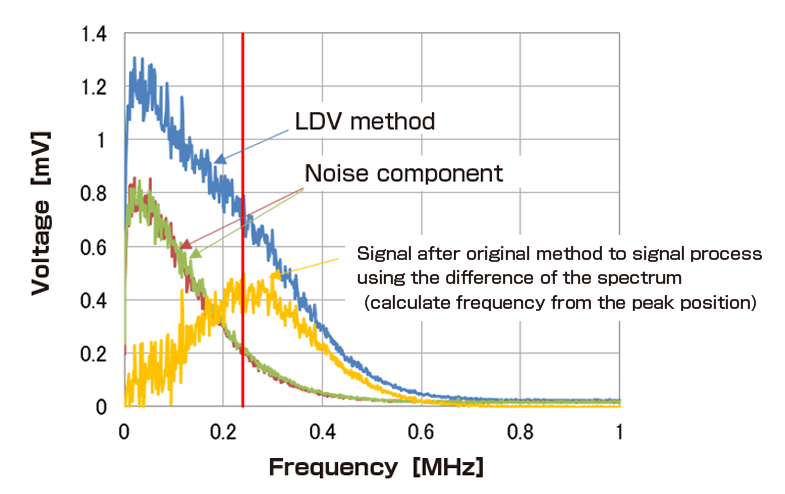Measure blood flow rate by means of light

In recent years, there has been a growing demand for “measurement of flow rate with less invasive way” in terms of medical use such as extracorporeal circulation. For example, in the field of dialysis treatment, the flow rate of blood circulating extracorporeally is controlled mainly using the values set on the roller pump.
However, instead of using such set values, if actual flow rate is known, it is expected to lead to more appropriate treatment, such as improvement / control of dialysis efficiency. 1). 2).
As a technique for measuring blood flow rate, the measurement method by means of ultrasonic waves has been realized, which is, however, not so used widely as expected because the equipment is large and costly. Then, as a technique for measuring blood flow with small equipment at low cost, we are studying blood flow measurement using Laser Doppler Velocimeter (LDV), a measurement method by means of light.

1). HITOMI Yasumasa, HAYASHI Michiyo, KINUGAWA Yumi, NAKAGAWA Hayato, SASAHARA Chisato, Hirota Eiji, TORIYAMA Seijiro, TAKAMURA Toshiya, SATO Nodoka, TODO Atsu, NISHIGAKI Takayuki, MIZUNO (MATSUMOTO) Yuko:
“A study on factors of changes in internal shunt flow and real blood flow volumes in patients during dialysis,” Journal of Japanese Society for Dialysis Therapy, 45(9):863-871,2012
2). OGIWARA Kiyomi, IRITANI Mayuko, NIKAIDO Mikio, SUZUKI Kazuhiro:
“Evaluation of access flow rate using dialysis monitor HD02 by Transonic,” The 56th General Meeting of Japanese Society for Dialysis Therapy, Subject No. O-137-2011
Measuring principles
LDV-type blood flow sensors adopt a measurement technology that uses interference phenomenon of light, which is specific to laser beams. As shown in the Figure below, when a beam emitted from the same light source is separated into two beams and they are crossed, a pattern of light and darkness called interference fringe is generated on the overlapped area.

When interference fringes are formed in the fluid, flow rate can be measured by obtaining, as Doppler signal, the frequency of the light and darkness of reflected light, which is generated when particles in the fluid (erythrocytes etc. when the fluid is blood) pass through the interference fringes.
That is, it is possible to measure selectively the velocity of only the part where interference fringes were formed (if concentration of the fluid is high, light is affected by multiple scattering, which disables measurement).The width (“d”) of interference fringes concerning measurement is determined according to the wavelength (“λ”) of light and the intersection angle (“θ”) of light as expressed in the following formula.

Further, when the particles to be measured pass through the area of interference fringes with the width of “d” at the velocity of “V”, the frequency (“f”) of the signal generated can be calculated with the following formula.
In actual measurement, since it is necessary to obtain the velocity (“V”) of measuring object, the scattered light that is generated when a beam passes through interference fringes is converted into a voltage signal using the dedicated signal processing circuit, and then the frequency (“f”) is obtained by conducting FFT analysis for the converted signal. The velocity V is computable from the frequency thus obtained and flow rate can be calculated using the cross-sectional area of the fluid path.

Realized measurement in high-concentration fluid
In measurement of a solid or low-concentration fluid by LDV-type sensor, velocity can be measured when particles (or unevenness on its surface in the case of solid) pass through interference fringes formed. However, in high concentration fluids, including blood as target of measurement herein, (concentration of human rythrocytes is about 40-50%), beams are repeatedly scattered by countless particles before they cross in the fluid.
This is called “multiple scattering.” As fluid concentration becomes higher, the effect of multiple scattering will increase and beams are scattered in excess of the intended area of interference fringes. For this reason, scattered light from area other than the intended area of interference fringes enters PD (photo detector) and becomes a noise component, which affects measurement.
In order to remove this noise component, we developed a original method to signal process using the difference of the spectrum (and applied for a patent). By removing noise components using this method, we realized stable velocity measurement even in a high concentration fluid.

Assuming application to dialysis, frequency generated by the particles that pass through the interference fringes becomes signal with a wide band of several hundred kHz to several MHz. For signals with a wide band, the property of signal processing circuit becomes worse particularly in the high frequency range. For this reason, measurement with high frequency (high flow rate) has been restricted, which has narrowed the range of measurement. In order to solve this problem, we realized the expansion of velocity measurement range for application to dialysis by optimizing circuit configuration and elements in order to obtain a signal of high SN ratio.
Voice of engineers

We had no knowledge about optical science when We began to work on this research, so We started from scratch. With cooperation of Sawada Laboratory, Kyushu University, a joint researcher at that time, we were taught about the principles, design, and other concepts of LDV-type sensors. Then, We learned the concept of approach to the research and difficulty in applying research findings as technology to internal operation, which was a very good experience. Since highly reliable measurement is required in the medical field, we continue to improve technologies so that they may be used in practice.